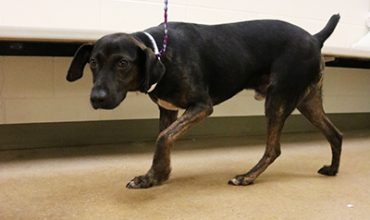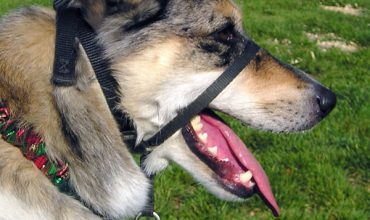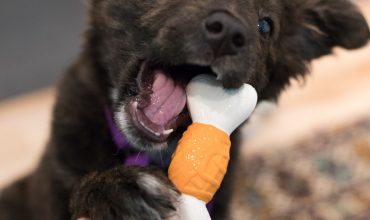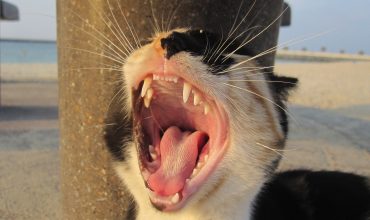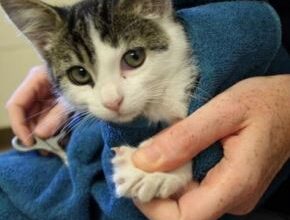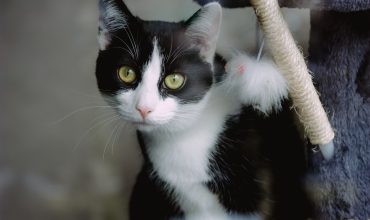It’s not uncommon for dogs to be frightened of thunder, firecrackers or other loud sounds. These types of fears may develop even though your dog has had no traumatic experiences associated with the sound. Many fear-related problems can be successfully resolved. However, if left untreated, your dog’s fearful behavior will probably get worse. The most common behavior problems associated with fear of loud noises are destruction and escaping. When your dog becomes frightened, she tries to reduce her fear. She may try to escape to a place where the sounds of thunder or firecrackers are less intense. If, by leaving
Read More
Archives for general behavior
The Fearful Dog
[print-me] This dog is a dog who has been fearful while in shelter and has taken longer than most to adjust to new situations. This dog should be given a significant amount of time to decompress and adjust once in the adopters home before adopters attempt to bring the dog new places or introduce new people or animals. Understanding and responding to the dogs’ body language will be very important in helping this dog adjust comfortably to his/her new home. Dogs who are fearful may attempt to communicate and/or show their fears in a variety of ways including; panting, pacing,
Read More
Desensitizing Dog to Head Halter
[print-me] Do the following exercises in order without skipping steps. The goal is to keep the dog comfortable the ENTIRE TIME. You want this to be like learning a trick. As the dog gets better and more excited to continue on, we progress through the steps. If the dog at any time is uncomfortable, go back a few steps to where the dog is comfortable and work that step a few more times before moving on. Hints & Tips Use no more than pea sized treats since you will be using so many Each head halter will be fitted by
Read More
Loose Leash Walking
[print-me] Things You’ll Need A standard leash, not a retractable or extendable leash. A bag full of treats he loves! A Gentle Leader chest harness can be a very helpful tool in teaching loose leash walking, especially for strong or bigger dogs. Do not use a standard harness that clips on the dogs back or you may be encouraging pulling. Also do not use any choke or prong collars. Those are not necessary and can be both painful and dangerous for your dog. Get Walking Fill your bait bag with treats, and put your dog on leash. You’ll want to
Read More
Dealing with Normal Puppy Behavior: Nipping
[print-me] When puppies play with each other, they use their mouths. Therefore, puppies usually want to bite or “mouth” hands during play or when being petted. With puppies, this is rarely aggressive behavior in which the intent is to do harm. Because puppies are highly motivated to exhibit this type of behavior, attempts to suppress it or stop it are unlikely to be successful unless you give your puppy an alternative behavior. The goals of working with this normal puppy behavior are to redirect your puppy’s desire to put something in her mouth onto acceptable chew toys and to teach
Read More
Dealing with Normal Puppy Behavior: Chewing
[print-me] Puppies may be just as much work as human babies – maybe more so because puppies can’t wear diapers and they have very sharp teeth! It’s definitely true that, similar to infants and toddlers, puppies explore their world by putting things in their mouths. In addition, puppies are teething until they’re about six months old, which usually creates some discomfort. Chewing not only facilitates teething, but also makes sore gums feel better. Although it’s perfectly normal for a puppy to chew on furniture, shoes, shrubbery and such, these behaviors can be a problem for you. A puppy won’t magically
Read More
Children and Dogs: Important information for Parents
[print-me] Living with a pet can be beneficial to children. Pets can enhance a child’s self-esteem, teach them responsibility and help them to learn empathy. However, children and dogs are not always going to automatically start off with a wonderful relationship. Parents must be willing to teach the dog and the child acceptable limits of behavior in order to make their interactions pleasant and safe. Selecting a Dog What age is best? Many people have a “warm fuzzy” image of a puppy and a child growing up together. If you have a young child and are thinking of adopting a
Read More
Your Talkative Cat
[print-me] Vocalizing is one way for your cat to communicate with you and with other animals. Some cats “talk” more than others, but most cats do make noise some of the time. We’re all familiar with the meaning of hissing and growling, but there are also many other sounds that your cat is capable of, and a variety of reasons for vocalizing. Medical Reasons If your cat’s behavior changes suddenly, the first thing you should do is take her to your veterinarian for a thorough health examination. Cats often hide symptoms of illness until they’re seriously ill. Any change in
Read More
Trimming Cat Claws
[print-me] The act of trimming your cat’s nails can seem like a daunting task, but there is good news: A team of people working with a cat can get a nail trim done in 20 seconds flat. A little trickier is doing this alone, but rest assured, it can be done! Unfortunately, there is also bad news: Many cats are not tolerant of nail trims, and many people are not skilled in the process. Below are some pointers that will hopefully help cat owners keep their cats’ nails trimmed. 1. Know those nails! Most cats have 18 nails (five on
Read More
Declawing Cats
[print-me] Adapted from the MSPCA and revised by the ASPCA’s Companion Animal Services Department The American Society for the Prevention of Cruelty to Animals encourages owners to seek alternatives to declawing their cats. If you are thinking about having your pet declawed, please take a moment to consider the following information. Claws Are Important to a Cat A cat’s remarkable grace and agility and its faultless sense of balance are due to a great extent to its retractable claws, which allow it to establish footing for walking, running, springing, climbing, or stretching. A cat’s claws are also its best defense
Read More





